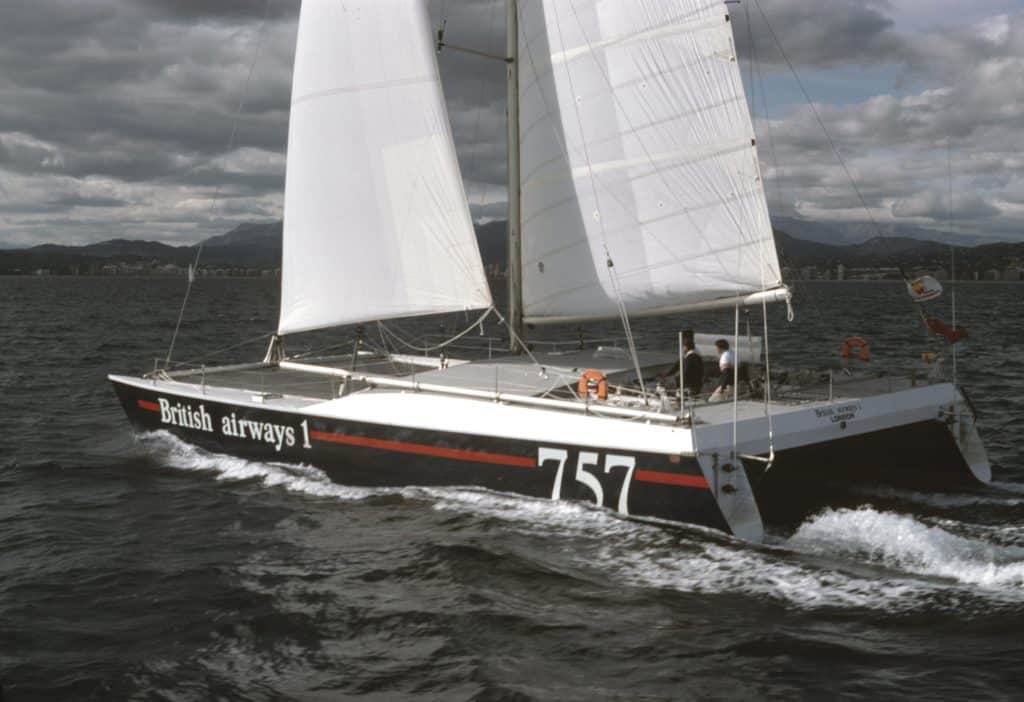
It was very windy and about to get much windier. In the early spring of 1986, aboard the 60-foot catamaran British Airways, we were less than 48 hours into our transatlantic record attempt when the whole show started going extremely sideways. Skipper Robin Knox-Johnston — already a legend, having become the first sailor to circle the globe alone and nonstop less than two decades earlier — gathered the crew in the cat’s rather cramped cockpit to outline the situation.
Robin explained that the low-pressure system we’d waited several days in New Jersey to latch onto — the plan had been to ride the low from Ambrose Light, off New York City, to Lizard Point, at the mouth of the English Channel — had morphed into a monster storm that was about to overtake us.
Had we been farther east, he said, we could have turned and run before the heavy southerlies, but because we were due south of the Grand Banks, that was no longer an option; the fast cat would tear into the relative shallows in hours. So the idea was to reduce sail and claw our way to weather, and if that didn’t work, stream warps off the bows and essentially park and maintain our position until the heavy weather passed.
“Now,” he said, as he once again reviewed where all the safety and survival gear was located, “if we capsize and I’m swept away …”
“Whoa, whoa, whoa, man,” I recall thinking. “Can you please slow down and run that past me again?”
This month, as we assemble our annual issue devoted to multihulls, I am reminded of my very first offshore trip on a seagoing catamaran. These days, of course, cats are everywhere, but that wasn’t the case 30 years ago. My voyage on British Airways was memorable for countless reasons.
There were some very good sailors aboard, including Robin’s fellow Brit Josh Hall and a young Frenchman named Bernard Gallay, both of whom would go on to compete in solo round-the-world races. The record we were chasing at the time was just shy of eight days, set by a giant French trimaran called Royale 2. Realistically, we didn’t stand much chance of bettering it, as British Airways was a much shorter, heavier boat, designed by Rod Macalpine-Downie. (A French sailing writer derisively nicknamed her “the truck of the seas.”) But that didn’t matter to me; I’d never been on a yacht that could knock off double-digit boat speeds for hours and hours on end. As far as I was concerned, B.A. did not refer to the vessel’s initials; nope, those letters meant Badass.
As it turned out, we got slapped around pretty well in the gale, but we kept the boat moving and emerged whole and unscathed. The real problem came in the aftermath, when the blow had pretty much sucked the breeze out of the entire Atlantic Ocean. For 72 hours after the storm, our engineless cat did little more than rise and fall on the greasy leftover swell. It was not a pleasant ride.
That said, it was still an adventure. We ate from one simmering pot the entire way across, a curry-based concoction Robin just kept throwing stuff into whenever it got low. The commode was basically a hole in the boat with a toilet seat bolted over it. Our Spartan sleeping quarters consisted of little more than a chilled crawlspace decorated with a smiling portrait of the queen, but at least they were dry. And when the BBC reported the news about Libya being bombed to bejesus, our captain, an ex-merchant mariner whose politics veered far to the right, was downright giddy.
But then the wind picked up, right on the beam, with some punch to it. For the next several days, we ripped off consistent 24-hour runs of well over 300 miles. In fact, we knocked off the second half of the Atlantic in about four days. If we’d managed that the whole way, we actually might have set a new record. But no matter — to this day it still stands as some of the best sailing of my life.
To punctuate the journey once we were tied up in England, Robin’s sponsor graciously forked over a ticket from London to New York on the Concorde. Talk about flying British Airways! I thought 12 days across the Atlantic was pretty darn quick — until it took me three hours to get home.
* Herb McCormick is Cruising World’s executive editor.*








